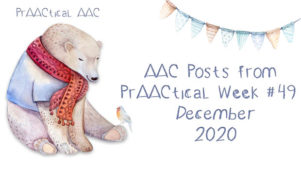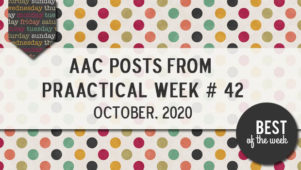Helping People with AAC Needs Develop Personal Narratives
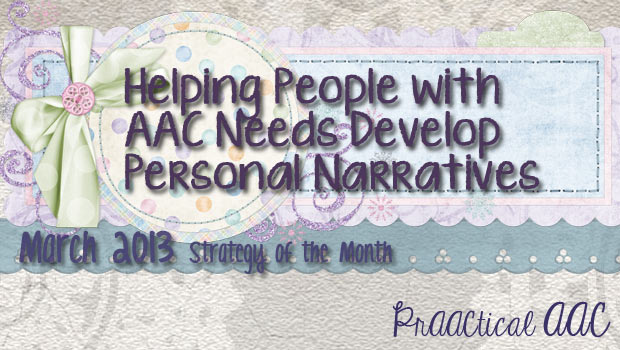
Where I come from, we value our independence. We look forward to the day when we can move out of our childhood homes into our first apartments. We’re intensely proud of our kids when they first do things on their own. We feel honored do to our first professional presentations or fly solo on a publication. We are driven to be independent in our professional and personal lives.
Independence is all well and good, but sometimes we get caught up in thinking that it’s the most important thing for our clients who use AAC. Many times, it’s not. As SLPs well know, communication is a social act. Without the cooperation of another person, there is no communication.We need other people in order to communicate and we need them even more when we’re just learning. Independence is something, but it isn’t everything. For AAC learners, interdependence plays an important role. We love the idea of working together to learn new information, create longer messages, and convey narratives.
There’s an emerging base of support for using co-construction to create personal narratives with children who use AAC 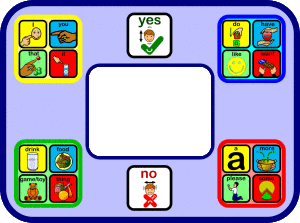 (Solomon-Rice & Soto, 2011). The basic idea is that the SLP uses a conversational approach in the therapeutic session to help the individual create a good personal narrative. When we co-construct stories, we take what the AAC learners tell us and build on it to come up with a narrative that is usually more coherent and advanced. To do this, we may model new vocabulary and grammatical concepts, ask questions, use prompts, offer encouragement to elaborate, and provide praise. The tone is conversational, with lots of give and take. In the end, the whole is greater than the sum of the parts.
(Solomon-Rice & Soto, 2011). The basic idea is that the SLP uses a conversational approach in the therapeutic session to help the individual create a good personal narrative. When we co-construct stories, we take what the AAC learners tell us and build on it to come up with a narrative that is usually more coherent and advanced. To do this, we may model new vocabulary and grammatical concepts, ask questions, use prompts, offer encouragement to elaborate, and provide praise. The tone is conversational, with lots of give and take. In the end, the whole is greater than the sum of the parts.
Co-Constructing Personal Narratives
Here are some of the things we consider when we’re working with someone who uses AAC and is learning to develop their narrative skills.
-
Get ready to make some inferences: Like many of you, we are generally pretty cautious when it comes to guessing
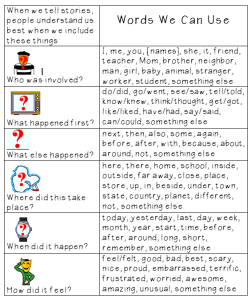 when AAC learners say things that are incomplete or unclear. Guessing is not something we do lightly, but this is one instance in which making inferences plays an important role. Co-construction depends on shared meaning, and sometimes that means we have to use the context and our knowledge of the learner to figure things out. Some of the
when AAC learners say things that are incomplete or unclear. Guessing is not something we do lightly, but this is one instance in which making inferences plays an important role. Co-construction depends on shared meaning, and sometimes that means we have to use the context and our knowledge of the learner to figure things out. Some of the -
Provide visual supports: We all do well when there are visual supports available to help us remember what to do. In this case, the visual support should be one that relates to the AAC learner’s goals. For example, Jenna was developing her ability to include various story elements in her personal narratives. We used a visual support like the one shown here in our intervention. (You can download it here.)
-
Consider using the language of storytelling: “I have a story to tell you.” “Tell me about the setting. I want to know where that happened.” “I am wondering about the characters. Who was there?”
-
Provide models: Most of us find learning easier when we have multiple examples of the target skill. Giving examples of the kinds of narratives you want the communicator to learn will go a long way in setting the stage for your instruction.
-
Make the focus clear: With Jenna, for example, we used the visual support to help alert her to the key components of personal narratives that we were working on.
- First, I used the story visual support to set the stage so that she was listening with a purpose. “Jenna, I want to tell you what happened to my car. And I’m going to try to include all these things. I’ll tell you who was there and what happened. I’ll try to tell you where we were and when it happened.”
- After the story, we went back to the visual support so she could rate me on the different elements. “So, how’d I do? Was my story easy or hard to follow?” Then we proceeded to talk about how well or poorly I did in telling about the people, actions, settings, etc.
- When it was her turn to tell a story, we revisited the visual support yet again. “Okay, now when you tell your story try to include these things.. Tell who was there and ….”
6. Build on what they give you: Help them flesh out their thoughts by asking questions and encouraging them to elaborate. “Okay, so I know you and Marissa went somewhere, but I’m not sure where. Can you explain that a little more?”
7. Keep it fun: Telling stories is an effortful process for many of our clients, particularly those with motor challenges. Do what you can to keep it fun. Not every story has to be told in one session. If it makes sense for your client, break it up so to make things easier.
8. Leverage the work: Once you co-construct a narrative, write it down so she can reread it later on. Consider pre-storing it in the SGD or providing another way to retell the story. Practice makes perfect, right?
Do you work on narrative skills with your clients learning AAC? We’d love to hear your stories about storytelling.
Selected References
Solomon-Rice, P., & Soto, G. (2011). Co-construction as a facilitative factor in supporting the personal narratives of children who use AAC. Communication Disorders Quarterly, 32, 2, 70-82.
Soto, G., Solomon-Rice, P.L., & Caputo, M. (2009). Enhancing the personal narrative skills for elementary school-aged students who use AAC: The effectiveness of personal narrative intervention. Journal of Communication Disorders, 42, 43-57.
Filed under: Strategy of the Month
Tagged With: co-construction, download, language therapy, narrative, storytelling, visual supports
This post was written by Carole Zangari


